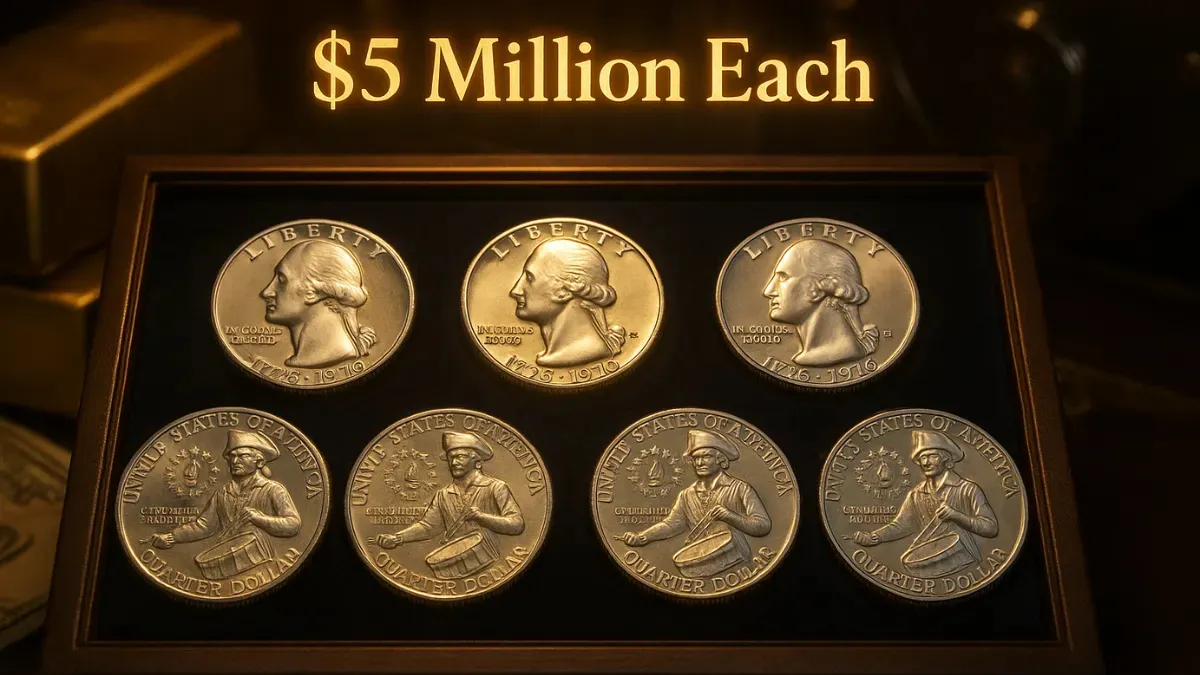Could Your 1976 Bicentennial Quarter Be Worth Over $5 Million? Here’s What You Need to Know
The 1976 Bicentennial Quarter is more than just a piece of history—it might be a hidden treasure. While most of these quarters are only worth face value, a few rare types have fetched more than $5 million at auctions due to their unique features and minting anomalies.
In this guide, you’ll discover what sets these high-value quarters apart, how to identify one, and the best ways to sell if you strike gold.
7 Rare Bicentennial Quarters Worth Over $5 Million
Released to commemorate America’s 200th birthday, the Bicentennial Quarter became an instant classic. However, only a handful of these coins are now considered extremely rare and valuable.
Here’s what collectors and investors look for:
| Topic | Details |
|---|---|
| Why are some worth millions? | Unique mint errors, silver content, and pristine condition boost value. |
| Key identifiers | Rare errors, unusual mint marks, silver composition. |
| Where were they made? | Philadelphia (no mark), Denver (D), and San Francisco (S – proof/silver). |
| How to assess value | Check for errors, weigh the coin, and have it professionally graded. |
| Where to sell | Reputable auction houses, online marketplaces, or certified coin dealers. |
| Helpful Resources | U.S. Mint website for background and reference. |
What Makes These Quarters So Valuable?
Most Bicentennial Quarters are still just common currency, but some possess characteristics that skyrocket their value.
1. Mint Errors
Rare errors can turn a basic coin into a collector’s dream. The most sought-after include:
- Double Die Obverse: Doubling effect on text or images.
- Off-Center Strikes: Misalignment during minting.
- Wrong Planchet Strikes: Quarters struck on different coin blanks, such as nickels or half dollars.
2. Silver Content
While standard quarters are made of copper-nickel, the U.S. Mint also released a 40% silver version as part of a special collector’s set. These silver quarters, especially with errors or proof quality, are worth considerably more.
3. Exceptional Condition (MS-67 or Higher)
Coins graded at MS-67 or above (by services like PCGS or NGC) can bring in tens of thousands—or even millions—depending on other traits like errors or rarity.
How to Identify a $5 Million Bicentennial Quarter
Think you might have a valuable coin? Follow these steps:
Step 1: Check the Mint Mark
- No mint mark: Philadelphia (common)
- D mark: Denver (also common)
- S mark: San Francisco (often silver or proof)
Step 2: Look for Errors
Use a magnifier to spot anomalies such as doubling, off-center designs, or missing details. These can drastically increase the coin’s worth.
Step 3: Determine the Metal
- Weight test: A regular quarter weighs about 5.67 grams. Silver versions weigh roughly 5.75 grams.
- Edge check: Silver quarters usually have a solid silver edge, without the copper stripe visible in clad coins.
Step 4: Get It Professionally Graded
Send your coin to a professional grading service like PCGS or NGC. A high-grade rating (especially MS-67 or higher) can raise its value significantly.
Step 5: Research Market Value
Look at recent sales on platforms like eBay or Heritage Auctions to get a sense of what similar coins are going for.
Where to Sell Your Rare Bicentennial Quarter
If you’re sitting on a rare coin, here are your top selling options:
- Certified Coin Dealers: Get a proper appraisal and competitive offers.
- Major Auction Houses: Heritage Auctions, Stack’s Bowers, and others can yield high returns.
- Online Platforms: eBay or Etsy can connect you with collectors (but be cautious of scams).
- Local Coin Shops: A fast and easy way to sell, although offers might be lower.
FAQs About Rare Bicentennial Quarters
Q1: Are all Bicentennial Quarters worth a lot?
No. Most are still worth 25 cents, but rare variations can be extremely valuable.
Q2: How can I tell if mine is silver?
Check the coin’s edge—if there’s no copper color and the weight is slightly higher, it may be silver.
Q3: What’s the highest price paid for one?
Over $5 million was once paid for an extremely rare proof error version of the Bicentennial Quarter.
Q4: Could I find one in everyday change?
It’s rare, but possible. Most of the valuable ones are already part of private collections.
Q5: Should I clean my quarter before selling?
Absolutely not. Cleaning a coin can ruin its value. Always leave it in its original condition.
Final Thoughts
While most 1976 Bicentennial Quarters won’t make you rich, a few rare examples can be worth a fortune. Keep an eye out for mint marks, silver content, and errors—these are the clues that separate common coins from million-dollar collectibles.
If you think you have something special, get it graded and explore your selling options. Who knows? You might just be holding a piece of American history worth millions.
